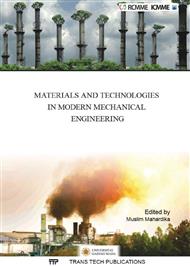p.61
p.67
p.74
p.83
p.92
p.99
p.103
p.111
p.115
The Effect Rust and Over-Protection Voltage of Impressed Current Cathodic Protection towards LR Grade a Steel Disbondment
Abstract:
Corrosion at the bilge due to direct contact with the seawater is an issue which is necessary to be taken into account. The problem can be solved by giving combined protection such as coating and cathodic protection impressed current cathodic protection (ICCP). For broader range, there is occasionally a possibility of over-protection at certain area especially that is close to anodes. It can trigger cathodic disbondment to occur. Cathodic disbondment is a situation when the coating loses its adhesion to the steel due to the voltage originated from cathodic protection. This trial was conducted by using several samples of LR Grade A plate coated by primer coat epoxy and top coat polyurethane. The plate was then given artificial defect with the size of R2, R3 and R4 accoring to ISO 4628-3 or is equal to 0,5% ; 1% and 8% of the plate surface width. Futhermore, impressed current cathodic protection was conducted with the steel anode, Ag/AgCl reference electrode and over-protection voltage were-1,5 ; -2,0 ; -2,5 ; -3,0 ; -3,5 and-4,0 volt. Electrolyte media employed was seawater. Furthermore, the disbondment taken place was measured after 6 hours and analyzed the corrosion product produced. In the research, it could be seen that the broader the defect was, the smaller the disbondment area was. The width of disbondment area was depending on current density. The smaller the voltage (volt) was, the broader the disbondment in accordance with the increase of disbondment width taking place on the plate surface. The corrosion product produced was Fe3O4 (Magnetite).
Info:
Periodical:
Pages:
92-98
Citation:
Online since:
June 2016
Keywords:
Price:
Сopyright:
© 2016 Trans Tech Publications Ltd. All Rights Reserved
Share:
Citation:


